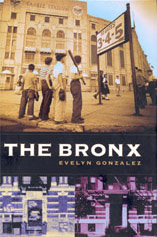Book Review
The Bronx
By Evelyn Gonzalez. New York, NY: Columbia University Press, 2004; 304 pp., illustrations; cloth $31.00; paper $19.95.
 |
Part of the Columbia History of Urban Life series, Evelyn Gonzalez's book, The Bronx, is an important contribution to the study of New York City's northernmost borough. The book traces the growth of the Bronx from its earliest, bucolic beginnings, through its devolution into a national symbol of urban decay and dysfunction, and to its phoenix-like resurgence in the late 20th century.
In The Bronx, Gonzalez argues that, contrary to popular belief, the plight of the Bronx was not the result of crime, racism, segregation, or big government. Rather, it was the outcome of "economic transactions, political decisions, and human choices that created the city and its ethnic and racial neighborhoods in the first place and then continuously re-created them." As the Bronx evolved from a group of suburban villages into a collection of urban neighborhoods, internal and external population shifts fostered a process of growth and change. As established residents became better off, they left their neighborhoods for neighborhoods further away from the city that were indicative of their improved status. The residences they vacated were inhabited by émigrés from the lower boroughs in search of more affordable and less crowded accommodations. The process repeated itself generation after generation, ultimately producing the ethnic enclaves for which the Bronx is so famous.
While the economic, political, and demographic determinism of Gonzalez's central argument is plausible and well supported by her research, it will certainly raise some eyebrows. It begs the critical question of whether the borough would have been allowed to descend into chaos had it, particularly the South Bronx, not gone from being majority white to majority black and Hispanic and, as she puts it, an extension of Harlem.
Gonzalez answers this question by pointing out that New York City turned its back on the Bronx at the height of the crisis. It cut back on police and fire protection, scaled back public transit and sanitation services, and ignored slumlords who allowed their properties to deteriorate, or worse, burned them down because the buildings were worth more "dead than alive." The banks also "redlined" whole areas of the South Bronx because they were presumed to be too risky for economic development or revitalization. One of the most telling incidents occurred in 1974, when local activist Genevieve Brooks escorted local dignitaries through the Bronx to show them how the borough was burning. Stunned by the group's indifference, Brooks said that "everyone thought that because this was a predominantly minority area it was just junkies and welfare folks. No one in authority was trying to combat arson." Gonzalez notes that everyone, from borough presidents to community leaders and elected representatives, "thought nothing could be done and thus did nothing. Accordingly, the South Bronx burned and the devastation spread."
This deterioration, in turn, hastened the process of white and middle class flight. Already fearful of crime and neighborhood decline, white ethnic and minority middle class residents moved out as poorer residents moved into the Bronx. Gonzalez cites a 1967 Fordham University study to show the effect of the demographic shift. The Bronx became poorer as its businesses and its white and minority middle-class moved to the suburbs. In their place came "thousands of Negro and Puerto Rican families" living in "abject poverty with little hope for the future." In short, people did not move to the South Bronx by choice.(1)
By 1978, it seemed as though the devastation would engulf the entire borough, and a coalition of borough residents, neighborhood organizations, and clergymen came together to address the crisis. They received help from New York City officials and downtown interests that had begun to worry that the problem might spread. The road back was slow and arduous, but by 1997, the Bronx had won the National Civic League's All-America City Award for its grassroots approach to solving its problems. The Bronx had become, Gonzalez concludes, "a place to live and to do business, not a place to escape from or move to on the way to somewhere else. There was life in the Bronx once again."
Well written and researched, The Bronx will appeal equally to cultural resource specialists and a general audience interested in the history of New York City and its environs. The story of the Bronx is a vivid example of what can go wrong when profit maximization and financial bottom lines alone drive urban planning decisions. Students of landscape architecture will be especially surprised and chagrined to learn that Frederick Law Olmsted was discharged from his position as the landscape architect for the New York City Parks Department because political hacks, property owners, and developers felt that his neighborhood designs for parks in the Bronx "wasted" too much valuable land.
Frank J.J. Miele
Southeast Regional Office
National Park Service
Note
1. Janet McDonald presents an excellent and enlightening account of this phenomenon on a microcosmic level in Project Girl (New York, NY: Farrar, Straus and Giroux, 1999). McDonald chronicles her early life in a Brooklyn housing project, the Farragut Houses, as its aspiring middle class residents were slowly replaced by permanently impoverished residents.
